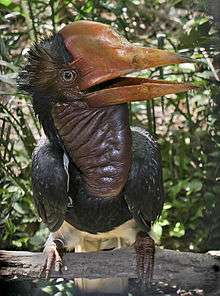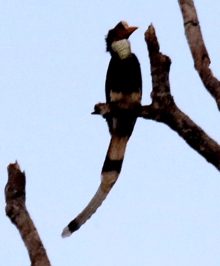Helmeted hornbill
The helmeted hornbill (Rhinoplax vigil) is a very large bird in the hornbill family. It is found on the Malay Peninsula, Sumatra, Borneo, Thailand and Myanmar. The casque (helmetlike structure on the head) accounts for some 11% of its 3 kg weight. Unlike any other hornbill, the casque is almost solid, and is used in head-to-head combat among males.[2] It is a belief among the Punan Bah that a large helmeted hornbill guards the river between life and death.[3]
| Helmeted hornbill | |
|---|---|
 | |
| immature male | |
| Scientific classification | |
| Kingdom: | Animalia |
| Phylum: | Chordata |
| Class: | Aves |
| Order: | Bucerotiformes |
| Family: | Bucerotidae |
| Genus: | Rhinoplax Gloger, 1841 |
| Species: | R. vigil |
| Binomial name | |
| Rhinoplax vigil Forster, 1781 | |
| Synonyms | |
|
Buceros vigil | |
Description

It has mostly blackish plumage, except that the belly and legs are white and the tail is white with a black band near the tip of each feather. The tail is long and the two central tail feathers are much longer than the others, giving the bird a total length greater than that of any other hornbill species. The body length is 110–120 cm (43–47 in), not counting the tail feathers, which boost the length a further 50 cm (20 in). One male weighed 3.1 kg (6.8 lb) in weight while two females averaged about 2.7 kg (6.0 lb). Although sometimes considered the largest Asian hornbill, they body weight appears to be similar to that of the great hornbill (and considerably less than the African ground hornbills).[4][5]
This species has a bare, wrinkled throat patch, pale blue to greenish in females and red in males. The casque goes from the base of the bill halfway to the tip, where it ends abruptly. It and the bill are yellow; the red secretion of the preen gland covers the sides and top of the casque and the base of the bill, but often leaves the front end of the casque and the distal half of the bill yellow. Unlike other hornbills, the helmeted hornbill's casque is solid, and the skull including the casque and bill may constitute 10 percent of the bird's weight.
Call
The call is a series of loud, intermittent barbet-like hoots, sometimes double-toned and over two dozen in number, which gradually accelerates to culminate in a cackle reminiscent of laughter.
Habits
Helmeted hornbills mostly eat the fruit of strangler figs. The birds breed once a year, producing a single chick. Mother and chick live inside a sealed tree cavity for the first five months of the chick's life. Males fight over territory on the wing, ramming each other with their casques[6]. Such encounters are called aerial jousting. Females accompany males during an approach in an aerial joust but veer off in opposite directions during the collision.[7]
It may also use the casque as a weighted tool to dig into rotten wood and loose bark in search of insects and similar prey.
Status
After ongoing hunting pressure and habitat loss, the helmeted hornbill was uplisted from near threatened to critically endangered on the IUCN Red List of Threatened Species in 2015. It is listed in Appendix I of CITES. According to the conservation group TRAFFIC, 2,170 casques were confiscated in just three years in China and Indonesia alone.[8] There are fewer than 100 birds remaining in Thai forests. At least 546 hornbill parts, mostly casques of helmeted hornbills, have been posted for sale on Thai Facebook in the past five years. Traders will pay villagers 5,000-6,000 baht (US$165–200) for a hornbill head. Prices double or triple in cities and increase exponentially when sold overseas.[9]
Ivory casque

The casque is the source of hornbill ivory, a valuable carving material. Indigenous peoples also use the central tail feathers to decorate dancing cloaks and head-dresses. Historically, the casque was also used by carvers in China and Japan.[10]
References
- BirdLife International (2019). "Rhinoplax vigil". IUCN Red List of Threatened Species. 2019: e.T22682464A155467793. Retrieved 20 April 2020.
- "The bird that's more valuable than ivory". Magazine. BBC News. 12 October 2015. Retrieved 19 October 2015.
- Archived February 4, 2012, at the Wayback Machine
- "Helmeted hornbill videos, photos and facts – Rhinoplax vigil". arkive.org. Archived from the original on 2012-04-16. Retrieved 2012-05-03.
- Dunning, John B. Jr., ed. (2008). CRC Handbook of Avian Body Masses (2nd ed.). CRC Press. ISBN 978-1-4200-6444-5.
- Bale, Rachael (September 2018). "Poached for Its Horn, This Rare Bird Struggles to Survive". National Geographic. Retrieved 20 April 2020.
- Kinnaird, Margaret; Hadiprakarsa, Yokyok; Thiensongrusamee, Preeda. "Aerial jousting by Helmeted Hornbills Rhinoplax vigil: Observations from Indonesia and Thailand". Ibis. 145: 506–508. doi:10.1046/j.1474-919X.2003.00188.x.
- "Helmeted Hornbills - Species we work with at TRAFFIC". www.traffic.org. Retrieved 2019-01-10.
- Sivasomboon, Busaba (11 October 2019). "Better protection sought for Thailand's helmeted hornbill". Minneapolis Star Tribune. Associated Press. Retrieved 12 October 2019.
- BBC Magazine (12 Oct 2015). "The bird that's more valuable than ivory". BBC. Retrieved 13 Oct 2015.
Further reading
- Perrins, Christopher (ed.) (2003). Firefly Encyclopedia of Birds. Firefly Books. ISBN 1-55297-777-3.CS1 maint: extra text: authors list (link)
- Kemp, Allen (1994). Hornbills: Bucerotidae. Oxford University Press. ISBN 0-19-857729-X. Quoted at
External links
| Wikimedia Commons has media related to Rhinoplax vigil. |
| Wikispecies has information related to Rhinoplax vigil |
